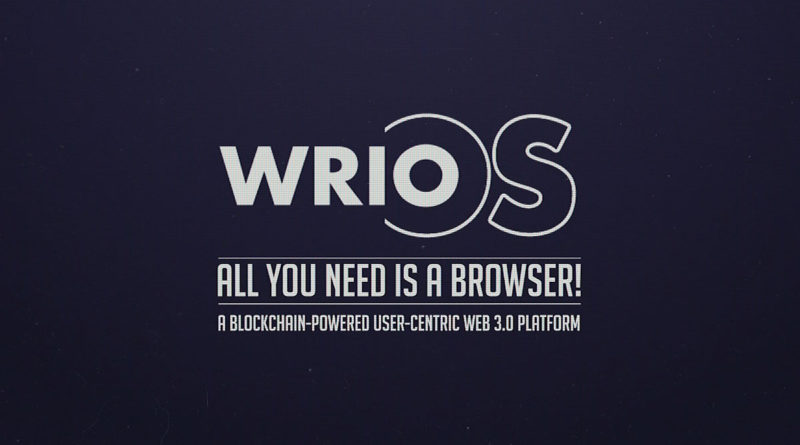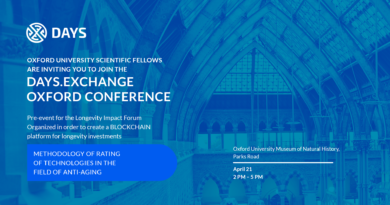WRIO Internet OS — All You Need is a Browser
The problem is the dominance of one search engine, one big social network, one Twitter for microblogging. We don’t have a technology problem, we have a social problem. The problem is not Google, or Amazon, or Facebook. The problem is that online users follow winner-take-all distribution. Is a structural distribution independent from the type of service. Making a new service will not change that.
— Tim Berners-Lee
Web today
WRIO Internet OS is your door to the realm of decentralized, semantic and safe Internet based on Open & Linked Data — a “decentralized Wikipedia” of open, shareable, reusable and machine-readable semantic data, thus enabling the creation of next generation services – mashup services using a global data pool without the need of API.
To understand the importance and value of Open & Linked data we recommend you to start with https://www.youtube.com/watch?v=OM6XIICm_qo TED. Tim Berners-Lee: The next Web of Open, Linked Data, and
https://www.youtube.com/watch?v=4x_xzT5eF5Q What is Linked Data?
The webpages of today are a mix of data and representation, which enables browsers to display information in a convenient way for reading. However, search engines have to parse them (separate data to analyze). The concept of WRIO Internet OS is that one and the same structure of webpages would be equally suited for browsing by users, and for “understanding” by computers.
At the time of the MVP launch, the platform supports creation of content-based posts from various sources: social media and services (1,800+ domains), featuring cryptocurrency donations instead of likes, and attracting new readers through a unique system of comments on the basis of tweets.
- Comment text input field; Twitter API transforms the text into a tweet (2)
- The tweet is displayed in the timeline with automatic link to the parent post and information about donated amount. It is visible to all followers of the comment author and contributes to the distribution of the content.
- The list of comments-tweets grouped by reference to the page https://twitter.com/search?f=tweets&q=vsauce.wr.io/index.html
An example of comments can be viewed at vsauce.wr.io, see comments area
Would you like to try WRIO OS? Create your first page and join the authors program with 1kg gold reward ($40,000 equivalent) in cryptocurrency.
Go deeper
Information below is intended for those interested in details and anxious to assess prospects to come:
The purpose of WRIO OS is to build web 3.0 – a semantic and distributed base of Open and Linked Data.
Each web 3.0 page is a set of atomic data about an integral and indivisible entity: a person, an organization, a book, a movie, a song, etc. It is not just a group of separate files; they are interrelated and create an integrated semantic network.
A simplified example of the code of interrelated pages:
Page 1:
url: whites.com/john.html
type: Person
firstName: John
familyName: White
sibling: whites.com/bob.html
…
Page 2:
url: whites.com/bob.html
type: Person
firstName: Bob
familyName: White
sibling: whites.com/john.html
alumniOf: alma-mater.org/index.html
…
Page 3:
url: alma-mater.org/index.html
type: Organization
name: Alma Mater
address: Somewhere 1/B
…
Such pages are based on JSON-LD schemas: simple text format that enables easy decentralized processing of pages, i.e. you’ll be able to read and use files stored on third party servers as if they were located on your own server.
In order to demonstrate the way web crawlers “see” JSON-LDs here is an example of the content: https://wrioos.com/jsonld-vis/view/?https://vsauce.wr.io
<body><script type=”text/javascript” src=”https://wrioos.com/start.js”></script></body>
connects to one of WRIO OS nodes that are gates into web 3.0 realm and are responsible for the rendering of the page (3) and all functions on the basis of cloud applications (4): authorization, support of social media posts, share, comments, transfer of funds and etc.
Now, to create a feature-rich web-site you no longer need to hire web developers or install CMS and a data base; there is no need to develop a UI, connecting modules and setting up SEO. You just need to fill in a page with information using our service, or any text editor, and then save it to WRIO OS, or any other service: Dropbox, Google Drive, etc.
For example, the hub at the above mentioned link includes pages and content distributed across various parts of web: AWS S3, Github, Dropbox, Youtube, and Twitter, and it’s code is as follows:
Now, let’s see the difference between web navigation as it is today and semantic web navigation.
Standard Internet Navigations
Typical pattern of a user’s interaction with websites is as follows:
website 1: user’s browser sends a request to the website and subsequently receives markup (HTML+UI), styles (CSS) and scripts (JS) responsible for the interactivity of communication. Services often disclose users’ data to third parties.
website 2: sites may be controlled by scammers, or contain viruses and malware.
website 3: web resources may be blocked by Internet service providers (ISP).
Semantic Internet Navigation
- No division into websites, and the Internet is a uniform interconnected semantic data network
- Data can be encrypted and protected against unauthorized access and fraud
- The textual nature of data excludes the possibility of malware penetration, provided that certain conditions are met
- You can create your own nodes, which will enable you to bypass blocking of resources even if the official WRIO node has been blocked.
Let’s compare web 2.0 and web 3.0
web 2.0 drawbacks
- current sites contain unstructured information that in a best-case scenario can be accessed with the help of APIs
- web-sites are easily blocked
- resource owners and third parties have access to users’ personal data
Advantages of web 3.0
- integrated network of semantic and linked data on the basis of JSON-LD. The format is supported by all major search engines. Learn more at schema.org
- hubs do not have domain boundaries – pages can be loaded from any sources, including Tor, I2P, IPFS, blockchain and so on
- open data — no copy/paste. Anyone can have access to public data distributed across all corners of the web without any limitations or need of parsing or API
- new types of services, platforms and social media using data from one source that always remain up-to-date and complete, ensuring consistency of the content
- data provided on a page can be encrypted and accessible only by the author and their trusted subjects
- censor-proof - The blocking of a resource or a WRIO OS node can be easily bypassed
- the text nature of JSON-LD guarantees absence of viruses, malware and other risks, enables caching and allows for the ease of Offline First development. Absence of CSS, JS, fonts and other elements makes small size pages possible. Large articles can be easily compressed to several dozens Kb, which saves traffic and minimizes load time. This will primarily be valued by mobile users.
- text format enables storage of and access to files over DHT, which provides new possibilities to create P2P Internet even without the need in WRIO OS nodes. This also gives access to pages from the Dark web networks by putting them together. General users won’t even notice that they are using the Internet segment that used to be off-limits to most of them. The pages will be displayed in a uniform style of user’s choice.
- user registration in WRIO OS is based on the Ethereum blockchain. During the registration process, access keys are created on the client side that also function as the user’s crypto-wallet. The approach makes the user independent of a particular node, and its hacking becomes meaningless, since no user data are stored there.
The official WRIO OS node is just one of the ways data may be processed and visualized. The entire code of the project is open source and can be used to set up your own node or to participate in the development. You can view draft documentation at https://github.com/webRunes/WRIO-InternetOS/wiki.
In the future, it will be possible to browse directly with the WRIO OS browser or plug-in. The browser will be more than just a page viewer; thanks to cloud applications it will open a new age of browser OSs that will become a fully-featured substitute of desktop OSs for many people. This will make the use of very simple and inexpensive devices with just a browser on board possible. Users will no longer need to know how to install and setup OS and other software – everything will happen by clicking a button, just like mobile applications do, yet without having to install, setup and update; everything will be done on remote servers, users will see just the results. This brings up a whole new market, whose scope surpasses that of the mobile applications market.
A network of such browser OSs will result in the evolution to semantic & distributed web, which will guarantee complete independence, maximum protection and anonymity to users.
Instead of standalone websites with restricted information, users will receive a shared pool of data while anyone will be able to participate in the development, replenishment and processing. Representation will not be mixed with data, which will be stored in a structured and widely accepted text format that will be easy to store, process, encrypt and transfer.
The shared pool of data will provide promising prospects of creating interrelated mashup services of a new type.
Summary. Web 3.0: The third generation web is coming
WRIO Internet OS is a cloud service with open source code, designed to navigate through decentralized, semantic and secure Internet. Some call it Web 3.0, the evolutionary replacement of today’s Web 2.0. The project is based on Ethereum blockchain technology.
WRIO OS is a PaaS and its applications are SaaS; it intends to replace desktop OSs in the future by delivering all required functions through cloud applications. Such services do not need to be installed, configured or updated by the user; resource-hungry operations are performed on the server side. Thus, enabling the applications act as conventional desktop programs.
It is this approach which allows the system to work with any device that has a browser and Internet connection, which is reflected in the project logo: “All you need is a browser”.
Distribution
- possibility for any user to publish posts specifying the author of the content. As a reward for their efforts and the assistance in bringing in more readers such users receive 25% of all donations made with respect to such content. The author receives an invitation, joins the project and receives the transferred donations
- Every time when leaving a comment, a user can make donations, and his/her tweet with the comment, donated amount and link to the post will be displayed to his/her subscribers. Thus the author can obtain new readers, and WRIO OS — new users
Advanced Guide https://goo.gl/4MpwHz
White Paper https://goo.gl/rVcPCV
WRIO Internet OS Bounty Campaign https://goo.gl/1rFUzQ
Crowdsale registration https://goo.gl/WGvdiu
Join our Slack Community https://join.slack.com/webrunes/shared_invite/MTgwMDQ1MTUxNzMxLTE0OTQyNDE2MTktYWZlNmYxODFlZA
Questions? [email protected]



